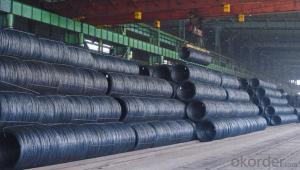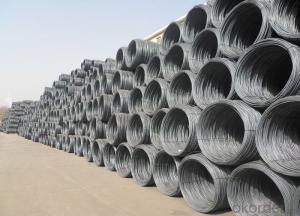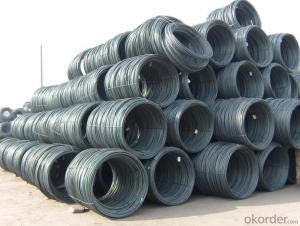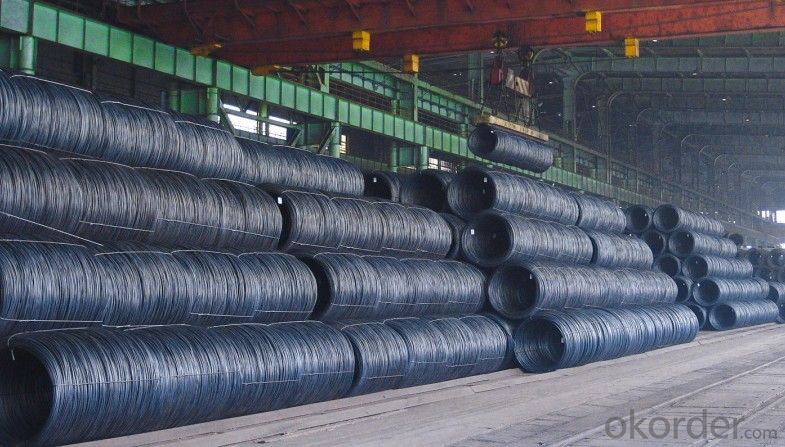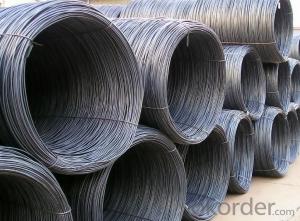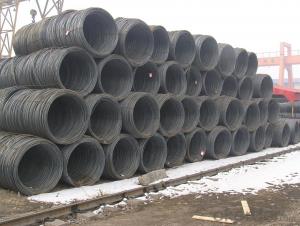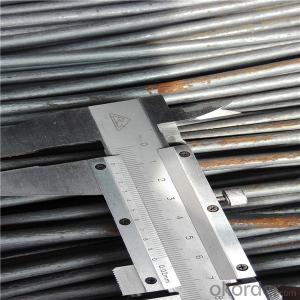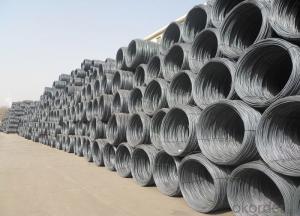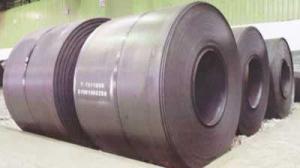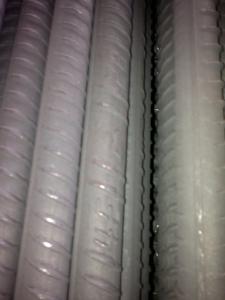Prime Hot Rolled Alloy Steel Wire Rods in Coil
- Loading Port:
- China main port
- Payment Terms:
- TT OR LC
- Min Order Qty:
- 100 m.t.
- Supply Capability:
- 10000 m.t./month
OKorder Service Pledge
OKorder Financial Service
You Might Also Like
Product Description:
OKorder is offering Prime Hot Rolled Alloy Steel Wire Rods in Coil at great prices with worldwide shipping. Our supplier is a world-class manufacturer of steel, with our products utilized the world over. OKorder annually supplies products to African, South American and Asian markets. We provide quotations within 24 hours of receiving an inquiry and guarantee competitive prices.
Product Applications:
Prime Hot Rolled Alloy Steel Wire Rods in Coil are ideal for structural applications and are widely used in construction and manufacturing. Carbon steel wire rod is mainly used for reinforcement of reinforced concrete and welded structure or reprocessed (roberts , nail, etc.) materials, especially used to produce wire drawing, welding electrode, nails, spring, electronic, precise machinery parts and so on.
Product Advantages:
OKorder's Prime Hot Rolled Alloy Steel Wire Rods in Coil are durable, strong, and wide variety of sizes.
Main Product Features:
· Premium quality
· Prompt delivery & seaworthy packing (30 days after receiving deposit)
· Can be recycled and reused
· Mill test certification
· Professional Service
· Competitive pricing
Product Specifications:
Steel Grade: SAE1006-1018B
Standard: ASTM, GB
Diameter: 5.5mm, 6.5mm, 7mm,8mm,9mm,10mm,12mm,14mm
Type: in coil, coil weight around 2MT
Alloy or Not: Alloy
Technique: Hot Rolled
Place of Origin: China Mainland
Surface: round, no twisted, light and smooth
FAQ:
Q1: Why buy Materials & Equipment from OKorder.com?
A1: All products offered byOKorder.com are carefully selected from China's most reliable manufacturing enterprises. Through its ISO certifications, OKorder.com adheres to the highest standards and a commitment to supply chain safety and customer satisfaction.
Q2: How do we guarantee the quality of our products?
A2: We have established an advanced quality management system which conducts strict quality tests at every step, from raw materials to the final product. At the same time, we provide extensive follow-up service assurances as required.
Q3: How soon can we receive the product after purchase?
A3: Within three days of placing an order, we will arrange production. The normal sizes with the normal grade can be produced within one month. The specific shipping date is dependent upon international and government factors, the delivery to international main port about 45-60days.
Images:
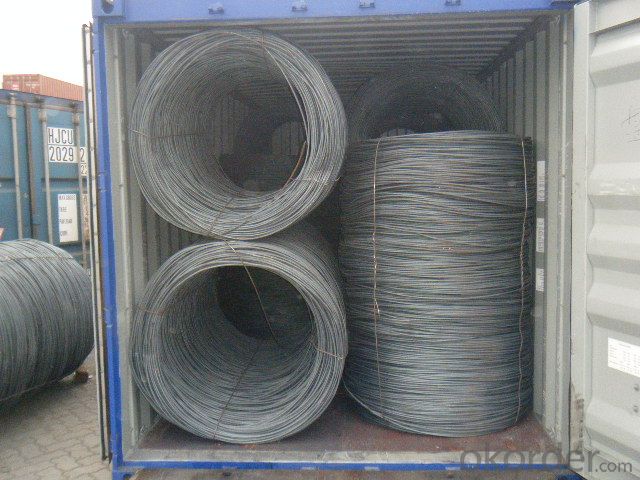
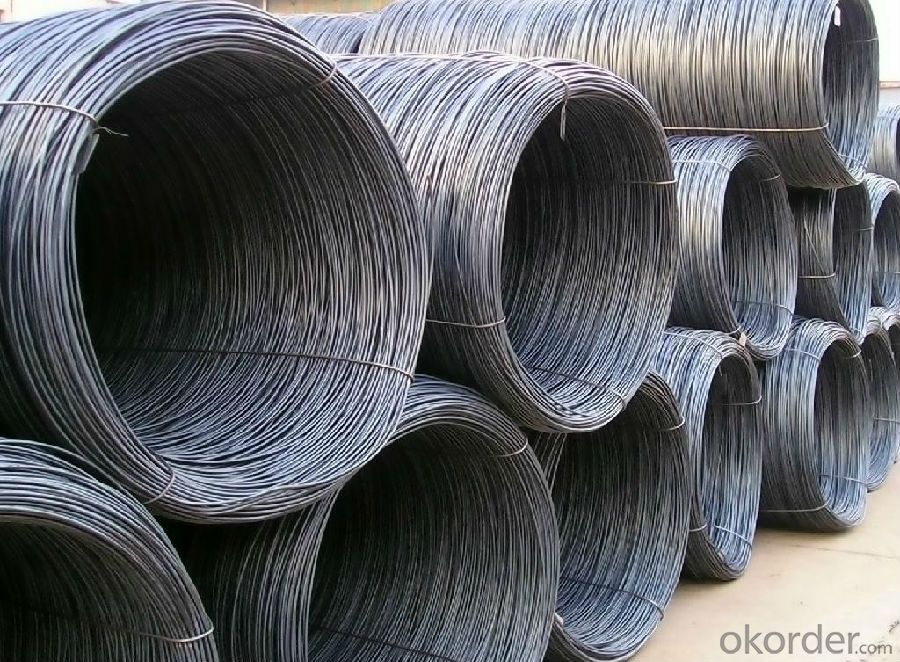
- Q: What are the common production processes for stainless steel wire rod?
- The common production processes for stainless steel wire rod include melting and refining of raw materials, continuous casting to form billets, hot rolling the billets into coils, annealing and pickling to remove impurities, cold drawing to reduce the diameter and increase the strength, and finally, surface treatment and packaging.
- Q: How is the tensile strength of steel wire rod determined?
- The tensile strength of steel wire rod is determined by subjecting it to a tensile test, where a sample of the wire rod is pulled until it breaks. The maximum force applied to the wire rod during the test is then divided by the cross-sectional area of the sample to calculate the tensile strength.
- Q: How does the carbon content affect the properties of steel wire rod?
- The carbon content in steel wire rod affects its properties by influencing its strength, hardness, and ductility. Higher carbon content generally results in increased strength and hardness, making the wire rod suitable for applications requiring high tensile strength. However, this also reduces its ductility, making it less flexible and more prone to breaking. Conversely, lower carbon content enhances ductility but compromises strength. Therefore, the carbon content must be carefully balanced to meet the desired properties for specific applications.
- Q: How is steel wire rod inspected for surface defects?
- The process of inspecting steel wire rods for surface defects involves two main methods: visual inspection and non-destructive testing. Trained personnel carry out the visual inspection, carefully examining the surface of the wire rod for any visible defects such as scratches, cracks, pits, or deformations. To ensure a thorough detection, proper lighting and magnifying tools are used. In addition to visual inspection, non-destructive testing techniques are used to further assess the quality of the wire rod. One commonly used method is magnetic particle inspection, where the wire rod is magnetized and a magnetic particle solution is applied on its surface. If there are any surface defects like cracks or discontinuities, the magnetic particles will cluster together, making the defect visible. Another method employed is ultrasonic testing, which involves transmitting high-frequency sound waves through the wire rod. Any internal or external defects will reflect these waves back, enabling the inspector to detect and measure the size and depth of the defects. Furthermore, eddy current testing is another non-destructive technique utilized for surface inspection. This method involves inducing an electric current in the wire rod and measuring the resulting magnetic field. Any surface defects will cause changes in the magnetic field, which can then be detected by the inspection equipment. Overall, a combination of visual inspection and non-destructive testing methods is used to ensure that steel wire rods undergo a thorough inspection for surface defects. This ensures that consumers receive a reliable and high-quality product.
- Q: What are the different surface marking materials used for steel wire rod?
- The different surface marking materials used for steel wire rod include paint, ink, and laser marking.
- Q: How are steel wire rods used in the production of wire mesh?
- Steel wire rods are used as a primary raw material in the production of wire mesh. The rods are first drawn through a series of dies to reduce their diameter and increase their length. These drawn wires are then fed into a mesh weaving machine, where they are interlaced to form a grid pattern. The resulting wire mesh is commonly used for various applications such as reinforcement in concrete, fencing, and filtration systems.
- Q: How is the impact resistance of steel wire rod tested?
- The impact resistance of steel wire rod is typically tested using a Charpy impact test. In this test, a notched specimen of the wire rod is subjected to a swinging pendulum that strikes and breaks the specimen. The energy absorbed by the specimen during fracture is measured, which provides an indication of its impact resistance.
- Q: What are the different surface finishing techniques for steel wire rod?
- Steel wire rods can undergo various surface finishing techniques to improve their appearance, durability, and functionality. Some commonly used techniques include: 1. Galvanizing: A layer of zinc is applied to the steel wire rod to protect it from corrosion. Galvanizing is widely used in outdoor applications like fencing, construction, and automotive industries due to its excellent rust resistance. 2. Electroplating: A thin layer of metal, like nickel or chrome, is electrochemically deposited on the surface of the steel wire rod. This technique enhances the rod's appearance and provides improved corrosion resistance. 3. Phosphating: The steel wire rod's surface is coated with a phosphate layer through a chemical process. This technique improves adhesion properties, corrosion resistance, and creates a suitable surface for subsequent coating or painting. 4. Pickling: Impurities and scale are removed from the steel wire rod's surface using an acidic solution. Pickling improves surface cleanliness and prepares the rod for further coating or painting. 5. Powder coating: A dry powder is applied to the surface of the steel wire rod and heated to form a protective and decorative coating. Powder coating provides excellent resistance to corrosion, impact, and UV rays, making it suitable for various applications like furniture, appliances, and automotive parts. 6. Passivation: A chemical process creates a protective oxide layer on the steel wire rod's surface to enhance corrosion resistance. This technique is commonly used for stainless steel wire rods to prevent rust and maintain appearance. 7. Anodizing: Although typically used for aluminum wire rods, anodizing can also be applied to steel wire rods. It involves controlled oxidation to form a durable and corrosion-resistant layer. Anodizing offers various decorative finishes and is commonly used in construction, aerospace, and automotive industries. These surface finishing techniques provide a wide range of benefits and can be chosen based on specific requirements like aesthetics, corrosion resistance, and durability for the steel wire rod's application.
- Q: How is steel wire rod used in the manufacturing of wire harness assemblies?
- Steel wire rod is used in the manufacturing of wire harness assemblies as it provides strength and durability to the overall structure. The wire rod is often used as the core material around which the various wires are wrapped and secured. This ensures the stability and integrity of the wire harness assembly, allowing it to handle high levels of electrical current and withstand mechanical stress. Additionally, steel wire rod is also used to create the connectors and terminals that are essential for connecting the wires within the harness, ensuring reliable electrical connections.
- Q: How is steel wire rod used in the production of wire strands for electrical transmission lines?
- Steel wire rod is used in the production of wire strands for electrical transmission lines by being stretched, twisted, and coated with protective layers to form strong and durable wire strands. These wire strands are then bundled together to create the conductive core of the transmission line, which carries electricity over long distances with minimal energy loss.
Send your message to us
Prime Hot Rolled Alloy Steel Wire Rods in Coil
- Loading Port:
- China main port
- Payment Terms:
- TT OR LC
- Min Order Qty:
- 100 m.t.
- Supply Capability:
- 10000 m.t./month
OKorder Service Pledge
OKorder Financial Service
Similar products
Hot products
Hot Searches
Related keywords
